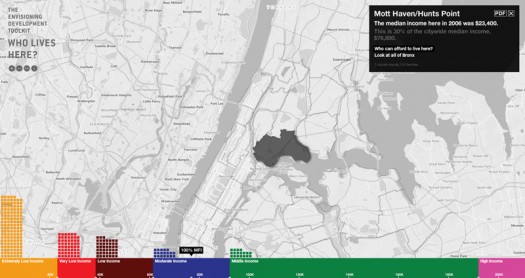
We are celebrating 15 years — and counting — of stories that are deeply researched and deeply felt, that build a historical record of what the city has been.
We are celebrating 15 years — and counting — of stories that are deeply researched and deeply felt, that build a historical record of what the city has been.

Screen grab from CUP’s Envisioning Development: Affordable Housing map
As you’ve probably heard by now, a state appeals court has barred the use of eminent domain for parts of a 17 acre site intended for development by Columbia University, ruling the condemnation unconstitutional. This on the heels of last week’s more developer-friendly rulings for Atlantic Yards and Willets Point. An appeal is expected, and regardless this does not halt Columbia’s broader Manhattanville plans (they already own much of the land in that parcel). But Diana Lind took a step back from these specific eminent domain decisions (also making note of the Pfizer/New London, CT mess) to ask if what really needs to be addressed is the existing definition of “blight.” She asks: “Is the definition of blighted problematic or is the whole concept of eminent domain the problem? I’m curious to know if there are lots of instances when non-controversial eminent domain usage radically transformed a neighborhood into a much better place. Any examples you want to share?” Head over to Next American City to voice your own opinion.
Adrian Benepe (Dept. of Parks and Recreation), Janette Sadik-Khan (Dept. of Transportation), Amanda Burden (Dept. of City Planning), and David Burney (Dept. of Design and Construction) are probably familiar names to many Omnibus readers, as are their respective programs and projects. Recently Claire Weisz of WXY Architecture and Julie V. Iovine, the executive editor of The Architect’s Newspaper, had a conversation with these urban design and development powerhouses about the High Line, city streets, temporary spaces, making ideas happen, BIM, working in a recession, and finding inspiration. Read it.
For more commissioner conversation, head over to WNYC to listen to Brian Lehrer’s interview with Rafael Cestero, commissioner of the Department of Housing Preservation and Development, about affordable housing, halted development, and Stuy Town. Before you listen, you may want to check out another project by our friends at the Center for Urban Pedagogy, which helps explain and illustrate what affordable housing means in New York City. (Remember our previous features on CUP’s work on Predatory Equity and Street Vendor rights.) This time they use one of their Envisioning Development Toolkits: there’s a guidebook (designed by Omni-contributor Glen Cummings), a chart, and an easy-to-navigate map that lets you chart the income demographics of any neighborhood in New York, and see what affordable housing means for those residents. Watch the video below to see how it all works.
Lehman College Art Gallery/CUNY have developed a nifty website documenting architecture in the Bronx called, appropriately enough, Bronx Architecture. The site features detailed profiles of over 75 buildings, biographies of architects who have worked in the area, historical accounts and archival photography of the borough’s neighborhoods, walking tours and maps, and even lesson plans and project ideas for teachers. The site was designed to be a companion to “Public Art in the Bronx,” a similar resource for information about public art and artists working in the Bronx.
The Roundup keeps you up to date with topics we’ve featured and other things we think are worth knowing about.
The views expressed here are those of the authors only and do not reflect the position of The Architectural League of New York.